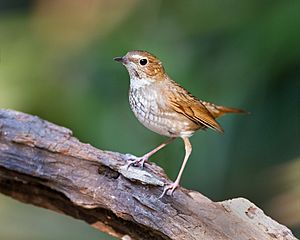Rufous-tailed robin facts for kids
Quick facts for kids Rufous-tailed robin |
|
|---|---|
 |
|
| In Khao Yai National Park, Pak Chong, Thailand | |
| Conservation status | |
| Scientific classification | |
| Genus: |
Larvivora
|
| Species: |
sibilans
|
| Synonyms | |
|
|
The rufous-tailed robin (Larvivora sibilans) is a small songbird. It lives and breeds in places like southern Siberia and parts of Asia. In winter, it flies south to warmer areas like southern China.
This bird has many other names! People sometimes call it the pseudorobin, red-tailed robin, or whistling nightingale. It is also known as Swinhoe's robin or Swinhoe's nightingale, named after Robert Swinhoe.
Contents
About Its Name: Taxonomy
Scientists group living things into different families. The rufous-tailed robin used to be in a group called Luscinia. But in 2010, scientists studied its DNA. They found that the Luscinia group needed to be split up.
So, the rufous-tailed robin moved to a new group called Larvivora. It is now known as Larvivora sibilans. This bird is most closely related to the rufous-headed robin.
The name Larvivora comes from Latin words. Larva means caterpillar, and -vorus means eating. So, it means "caterpillar-eating." The word sibilans is Latin for "whistling."
What Does It Look Like?
The rufous-tailed robin is about the same size as the European robin. It is about 14 cm (5.5 in) long.
Its back is plain grayish-brown. Its belly is gray to white. It has cool, round pale spots on its throat and chest. Its rump and tail are a bright reddish-brown color. The sides of its body are buff-colored. It also has a whitish ring around its eye and a clear buff stripe on its cheek.
Its beak is brownish-black, and its legs are pinkish-gray. The tip of its lower beak points up a little. Male and female robins look very similar. Young robins look like adults but are a bit more yellowish.
Its Song and Calls
Male rufous-tailed robins sing during the day. During the breeding season, they also sing at night. Their song sounds like loud, flowing trills. It starts high and ends lower, a bit like a horse's neigh.
When the bird is worried, it makes whistling sounds. When parents have young birds, they make a jingling "chok-chok" sound.
Where Does It Live and Travel?
The rufous-tailed robin is a migratory bird. This means it flies long distances between seasons. It eats insects.
It breeds in forests in northeastern Asia, like Siberia and Mongolia. When winter comes, it flies south to warmer places. These include Southeast Asia and southern China.
Sometimes, these birds fly off course. They have been seen in Western Europe. The first time one was seen in Europe was in Scotland in 2004. Others have been spotted in Poland, England, and Denmark.
Its Favorite Places
This robin likes conifer forests. It also likes damp forests with broad-leafed trees. It prefers areas with fallen trees and thick bushes. You might find it near spruce and fir trees, or willow, alder, and birch trees.
It mostly lives in low areas. But sometimes, it can be found up to 1,200 meters (4,000 feet) high. In winter, it lives in forests, parks, and gardens.
How It Lives: Daily Habits
This bird can be hard to see. It likes to hide among branches and stay still for a long time. It mostly stays on the ground.
It eats insects. Its favorite foods are ants, beetles, spiders, and other small creatures. It often flicks its tail in a special way.
Family Life: Reproduction
Rufous-tailed robins usually breed in June or July. Their nest is shaped like a cup. They often build it in a hole in a tree or on a tree stump. The nest is usually close to the ground.
They build their nests from dead leaves, grasses, and moss. They line it with softer materials. A female usually lays five or six eggs. The eggs are plain pale blue or bluish-gray. They might have brown spots.
Migration After Breeding
The birds start flying south soon after their young can fly. This happens in late August in Russia. In Korea, it's a few weeks later.
They arrive near Hong Kong in November. They also spend winter in Thailand, Laos, and Vietnam. In the spring, they fly north again. They reach Korea in May and Russia by early June.
Is It Safe? Conservation Status
The IUCN (International Union for Conservation of Nature) looks at how many of each animal species there are. They say the rufous-tailed robin is of "least concern."
This is good news! It means there are many of these birds. They live in a very large area, and their numbers seem to be steady.


